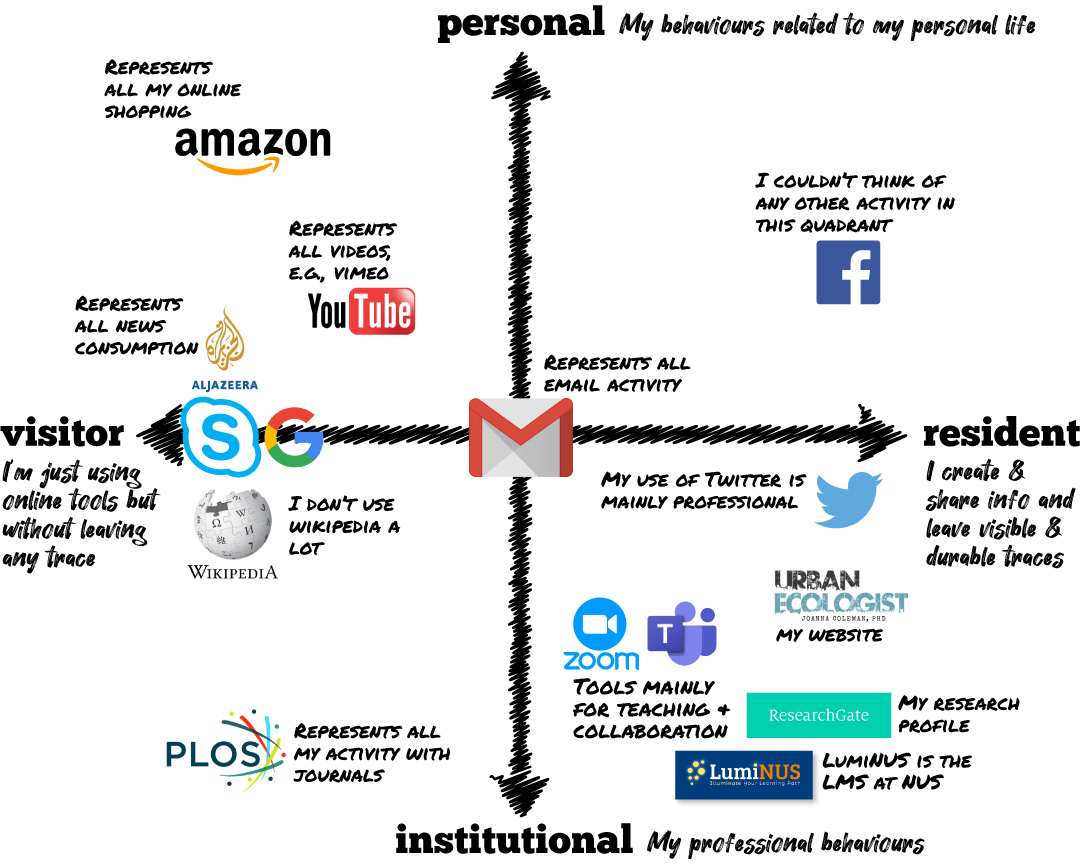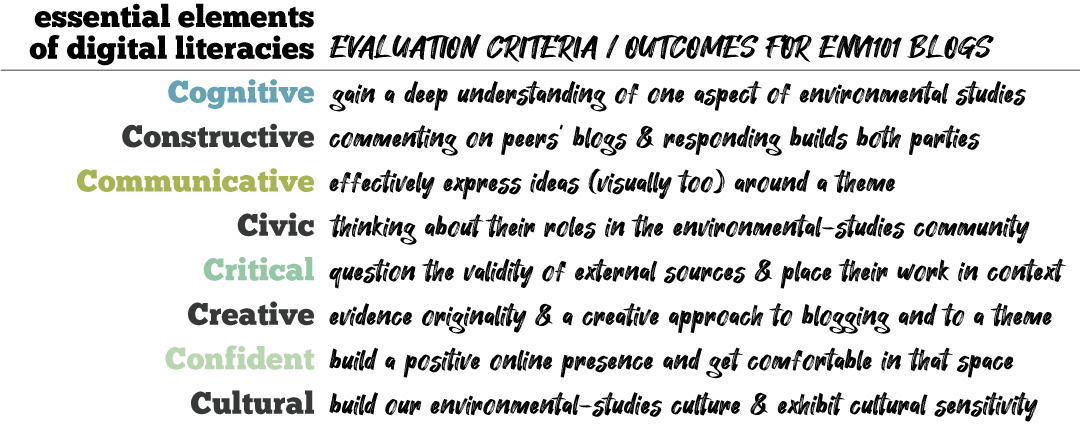Until this week’s topic, I’d never given much formal thought to the concept of digital literacies or even heard of Prensky’s digital natives vs immigrants dichotomy. So the paper by White & Le Cornu’s and David White’s video were enlightening. What resonated most with me were the assertions that there isn’t a dichotomy so much as a spectrum and that our motivations more than our age determine which online spaces we inhabit and how.
White’s characterisation of online behaviours into four quadrants based on crossed continua from digital visitors to residents and personal to institutional inspired me to think about the nature of my online activities (and to ‘remix’ the diagram – I quite liked Doug Belshaw’s idea of remixing as a pathway to developing digital literacies). My result is below, but it was just as interesting to see similar comparisons by other ONL participants during our webinar. It all just reinforced (for me) the need to be aware of diverse digital literacies.

Ultimately, I think as a late Gen-Xer – I remember the dawn of the Internet and social media but have been using them for more than half my life – I am comfortable online and readily acquire new literacies, like how I quickly adapted to teaching online last semester. Meanwhile, I sometimes feel like a luddite compared to my students and unable to relate to certain aspects of their behaviours.
For instance, the way Millennials and Gen-Z have these online personas, their selfie culture and, above all, their habit of turning to social media as a news source and gauging the validity of information by its popularity. I say “above all” because before watching White’s video on credibility, I was already alarmed by what I see as a growing tendency to scan a headline (why read the whole story?) or see a meme and deem the info worth spreading almost as if it were peer-reviewed or at least published and verifiable.
The amount of misinformation and disinformation online is a huge concern, especially at a time when humanity is facing its greatest challenge – the environmental crisis. A crisis that can only be solved via an approach that is based on evidence and grounded in ethics. Reflecting on this week’s materials, I realised something encouraging about my practice. For four years, I’ve been engaging my environmental-studies students with online assignments (blogs) that develop Belshaw’s eight essential elements of digital literacies, i.e., the 8Cs as in the diagram below (again remixed). Hopefully this will contribute to my end goal of graduating environmental change-makers.

IMAGE ATTRIBUTIONS
All logos used in the upper figure are in the public domain, except the three below.

I as a very early Millenial, but feeling more like a Gen-Xer, and as a mother, I must say I am frightened about the selfie culture and what it do to people´s self-esteem. It is however, refreshing to see that more and more people is starting to show “irl” pictures in a try to change this trend.
I totally agree with you about using headlines as news source. However, just taking FB as an example, I must say I see a lot of people also from older generations, that does not seem to think it is worth to read more than the headlines or to question the contents. It is really scary, and I wonder if it might be this enormous amount of information in the society, that creates this behaviour.
Hi Therese,
Thanks so much for your comment ! If I had kids, I’d be very concerned about their growing up in a society where your self-worth is judged by how many likes your photo gets more than by the thoughts and behaviours you put out there. And I’m very grateful to have been a kid at a time when my main concern during any activity was being in that moment rather than how I looked in that moment. So I totally feel you.
And I guess, come to think of it, many of my FB friends (who are also in their 40s) and even older folks are doing exactly what you’re referring to. In fact, one of my mum’s friends regularly posts stuff that perpetuates fascist ideology and/or conspiracy theory nonsense. So maybe I shouldn’t have been so quick to suggest that this is mainly a Millenial / Gen Z behaviour. You might be interested in this 2008 article, from The Atlantic.
https://www.theatlantic.com/magazine/archive/2008/07/is-google-making-us-stupid/306868/
And it occurs to me that this might be an excellent topic for a study, especially if an experimental approach could be adopted. Perhaps this is something for a future student in my lab to investigate, as long as we can bring in the relationship to urbanisation.
I really enjoyed reading this entry. I also love how you’ve applied Belshaw’s eight essential elements of digital literacies to your own sphere. You certainly have created a positive online presence!
Hi Sonita,
Thank you so much for your supportive comment ! I really appreciate that. Hope ONL202 is going well for you.